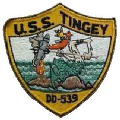Click On Image
For Full Size Image |
Size |
Image Description |
Contributed
By |
 |
18k | Thomas Tingey was born in London, England, 11 September 1750, the son of a clergyman of the Church of England. In his youth he served as an officer in the British Navy, as shown by an order to him dated 31 July 1771, from Commander-in-Chief of the British Squadron off Newfoundland to take command of a blockhouse on Chateaux Bay, Coast of Labrador. He left the British service, however, and commanded merchant vessels trading with the West Indies. Prior to the Revolutionary War he is said to have come to the United States, marrying an American girl in 1777. No record of service in the Continental Navy (the branch directly under control of the Continental Congress) has been found, but the Navy of the Revolution was made up of many elements, and the records are far from complete, and it is quite possible that he may have served the cause of the Colonies in some capacity. Following the War he engaged in the American merchant service. The United States Navy was established in 1794, and Thomas Tingey was commissioned a captain in it September 3, 1798. During the War with France (1798-1801) he commanded the ship Ganges of 24 guns, which with the brig Pinckney and the revenue cutter South Carolina, formed a squadron to guard the Windward Passage. During the summer and autumn of 1799, after the departure of Commodores Barry and Truxtun, Commodore Tingey was ranking naval officer in the West Indies, commanding all vessels on what was called the Guadeloupe Station. Numerous prizes were captured, four by the Ganges while under his command. On 22 January 1800, Commodore Tingey was appointed to lay out and command the new Navy Yard at Washington, D.C. He was discharged from the Navy under the Peace Establishment Act of 3 March, 1801, but was retained as superintendent of the Washington Navy Yard. On November 23, 1804, he was recommissioned a Captain in the Navy and made Commandant of the Washington Navy Yard and naval agent, which posts he held until his death. When the British invaded the capital in the summer of 1814, the Secretary of the Navy ordered Commodore Tingey to fire the Navy Yard. He wrote to his daughter under date of 17 September 1814, "I was the last officer who quitted the city after the enemy had possession of it, having fully performed all orders received, in which was included that myself retiring, and not to fall into their possession. I was also the first who returned and the only one who ventured in on the day on which they were peaceably masters of it". Commodore Tingey died on 23 February 1829, in Washington, and was buried with "unusual military honors" in the Congressional Cemetery, Washington, D.C. The title of Commodore was a courtesy title, given to a Captain (the highest rank in the Navy until 1862).
Portrait of Thomas Tingey from the Naval Historical Center Art Gallery Collection. | Bill Gonyo |

| 13k | Undated, location unknown. | - |

| 107k | USS Tingey (DD-539) underway off San Francisco, California on 30 November 1943. Photographed by The Bethlehem Steel Company, San Francisco Yard. Official U.S. Navy Photograph, from the collections of the Naval History and Heritage Command. Photo #: NH 50285. | Robert Hurst |

| 134k | The USS Tingey (DD 539) off Mare Island on August 26, 1945. Photo from the collection of the Vallejo Naval and Historical Museum. | Darryl Baker |

| 131k | Navy Photo 6275-45, amidships looking aft plan view of USS Tingey (DD 539) to the left and USS Roe (DD 418) to the right at Mare Island on 30 Aug 1945. Tingey was in overhaul at the yard from 9 July to 1 Sep 1945. | Darryl Baker |

| 99k | Navy Photo 6277-45, forward plan view of USS Tingey (DD 539) to the left and USS Roe (DD 418) to the right at Mare Island on 30 Aug 1945. | Darryl Baker |

| 299k | The Tingey's crew on October 17 1945. | Jim Geldert |

| 171k | Four Grumman F9F-2B Panthers from Squadron VF-721 in flight over the USS Tingey (DD-539) on July 27, 1951. US Navy and Marine Corps Museum/Naval Aviation Museum, Photo No. 2011.003.281A.007. | Mike Green |

| 42k | USS McDermut (DD-677), USS Yarnall (DD-541), USS Tingey (DD-539) and USS Boyd (DD-544) alongside the USS Piedmont (AD-17) in Sasebo 1952. | Lloyd W. Haase |

| 107k | Hong Kong harbor circa 1954. | R. Wright |

| 55k | USS Delta (AR-9) with the USS McDermut (DD-677), USS Yarnall (DD-541), USS Tingey (DD-539), USS Boyd (DD-544) and USS Horace T. Bass (APD-124) in Sasebo, Japan, 1955. | Ted Bojanowski |

| 197k | Another view of the above photo from the collection of SFCM James H Cary. | Mike Cary |

| 74k | Circa 1957, location unknown. | Gerald Sumners |

| 211k | USS Colahan (DD-658), USS Watts (DD-567), USS Tingey (DD-539) and USS Laws (DD-558) in Sasebo, Japan circa 1960-1962. | John J. Gobbell |

| 177k | In San Diego circa 1960-1962. | John J. Gobbell |

| 69k | Mounts 51 and 52 circa 1960-1962. | John J. Gobbell |

| 170k | USS TIngey DD 539, after collision with USS Vammen, dated August 4 1963, photo credit is United Press International. | David Buell |

| 40k | Ship's patch. | Mike Smolinski |


